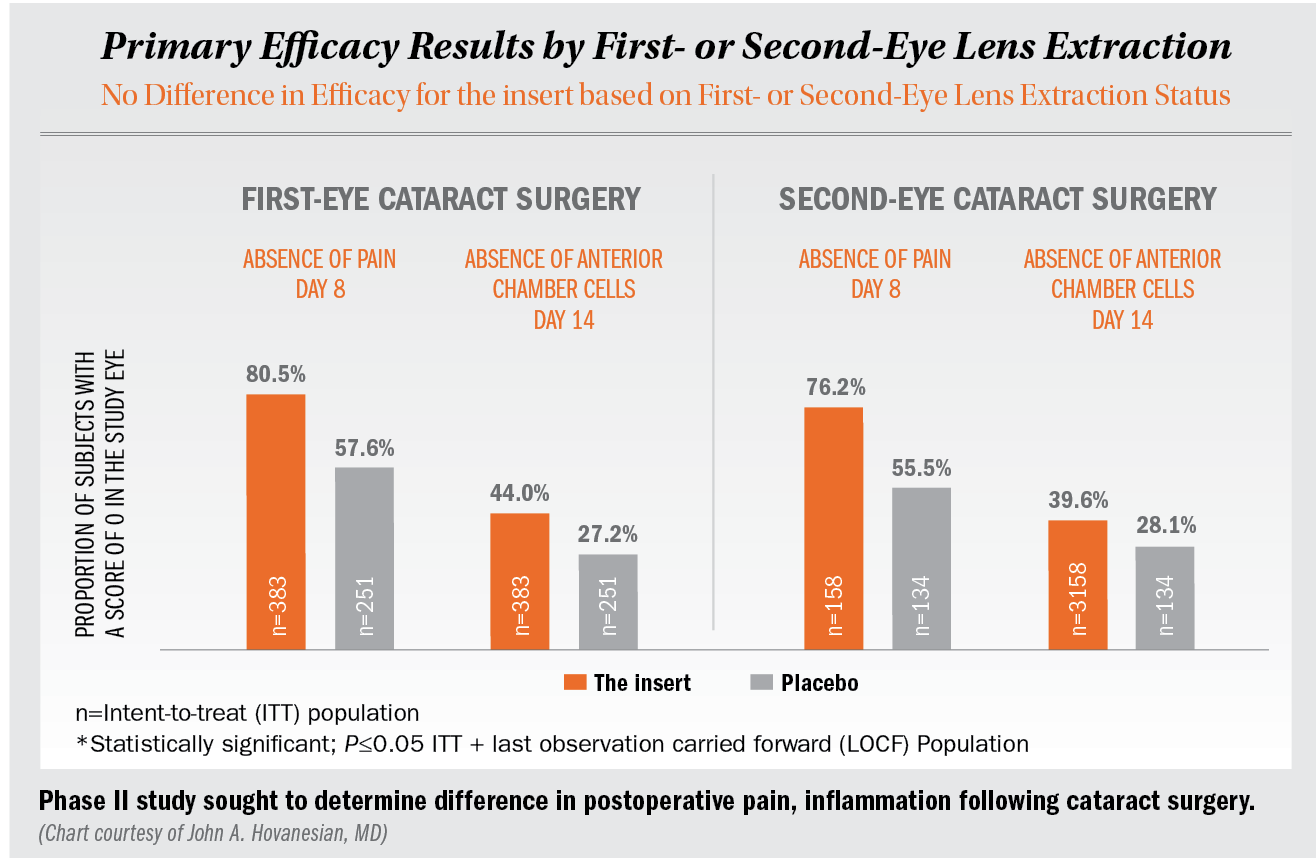Article
Dexamethasone insert reduces postsurgery burden
Author(s):

The dexamethasone ophthalmic intracanalicular implant, 0.4 mg may eliminate the need for corticosteroid drops after cataract surgery.
This article was reviewed by John A. Hovanesian, MD
The dexamethasone ophthalmic intracanalicular insert, 0.4 mg (Dextenza, Ocular Therapeutix Inc.) seems to be filling an unmet need by reducing the pain and inflammation after cataract surgery in the second eye to a level that is comparable to pain in the first eye that underwent cataract surgery.
Postoperative pain and inflammation generally are greater after a cataract extraction performed in the second eye compared with an initial cataract extraction in the first eye. As a result, the availability of a drug/device that would lessen or eliminate that pain and inflammation would be a boon to this patient population.
Related: Innovations focusing on improved patient experience
According to John Hovanesian, MD, clinical instructor, UCLA Jules Stein Eye Institute, Laguna Hills, CA, the increased pain in the second eye is hypothesized to result from sympathetic irritation during the surgery in the first eye.
“This makes the fellow eye more prone to painful stimuli, or to memory traces of pain from the surgery in the first eye, however small, that may linger for weeks postoperatively,” he said.
The development of inflammation following the second surgery also is affected by the inflammation in the first eye.
“This may be mediated by the chemical mediators monocyte chemoattractant protein-1 and possibly transforming growth factor beta 2, the levels of which are elevated in the second eye at the time of surgery compared with the first eye,” Dr. Hovanesian explained.
Related: Achieving successful results with refractive cataract surgery
The dexamethasone insert, which was FDA-approved in 2019, is put into the punctum of the lower lid after an ophthalmic surgery to provide an anti-inflammatory effect and serves as a substitute for the instillation of corticosteroid drops during the postoperative period. In addition to reducing the postoperative treatment burden, the insert also provides sustained and continuous tapered delivery of dexamethasone for up to 30 days after surgery.
In preparation for the insert to be placed, the lower lid is drawn laterally and the punctum is dilated. Importantly, the surface is dried to prevent the insert from becoming wet and swelling almost immediately, Dr. Hovanesian said.
Related: Weight risks, benefits of cataract surgery for your patients
Phase III study
A phase III study with three study arms was conducted to determine the difference in postoperative pain and inflammation following cataract surgery in the first and seconds eyes of patients who received the dexamethasone insert.

The study included 541 patients randomly assigned to the dexamethasone insert and 385 patients randomly assigned to placebo, with both groups followed for more than 30 days. The primary end point was the absence of pain on Day 8 postoperatively and the absence of anterior chamber cells on Day 14 postoperatively. The safety of the insert also was evaluated.
Almost one-third of the eyes underwent cataract surgery in the second eye, 30.3% in the insert group and 33.2% in the placebo group.
Related: Surgeons explore dropless for cataract surgery
A subgroup analysis of those two groups showed that compared with patients who received dexamethasone and placebo during cataract surgery in the first eyes, there were similar levels of absence of pain and inflammation following surgeries in the second eyes.
Evaluation of the use of rescue medications showed as expected that these medications were used more often in the patients in the placebo groups undergoing surgeries in the first and second eyes, Dr. Hovanesian reported.
The safety results, based on the results of a pooled analysis of three arms of the phase III studies, were similar between the patients who received the insert and those who received placebo.
Related: Understanding the surgical learning curve
Common ocular adverse events, such as anterior chamber inflammation, eye inflammation, reduced vision, corneal edema, and cystoid macular edema, occurred in more than 1% of the eyes that received the insert.
A slightly higher increase in IOP was seen on Day 1, which decreased thereafter, in the dexamethasone group that Dr. Hovanesian believes was related to the viscoelastic agent used.
Related: Tackling postop IOP head-on with sustained-release option Conclusion
Dr. Hovanesian noted that about a third of the trial participants were undergoing a cataract surgery in the second eye in the dexamethasone and placebo groups.
“The results showed that the control of inflammation and pain was similar in both groups,” he said. “The dexamethasone was safe and well tolerated in both the eyes of patients that underwent surgeries in the first and second eyes.”
Moreover, Dr. Hovanesian noted that the current results were consistent overall with the pooled data in the pivotal study.
“We believe this is important because if the dexamethasone insert were providing an inadequate level of inflammation control, a different result might be evident, that is, greater inflammation and greater persistent pain would have been evident in the second eyes undergoing cataract surgery,” he concluded.
Read more by Lynda Charters
John A. Hovanesian, MD
E: jhovanesian@harvardeye.com
This article was adapted from Dr. Hovanesian's presentation at the American Academy of Ophthalmology 2019 annual meeting. Dr. Hovanesian reported receiving grant support from Ocular Therapeutix, Inc.
Newsletter
Don’t miss out—get Ophthalmology Times updates on the latest clinical advancements and expert interviews, straight to your inbox.




